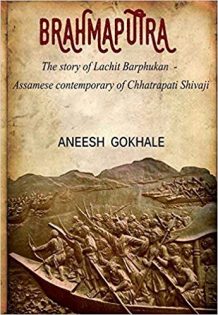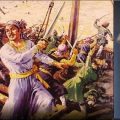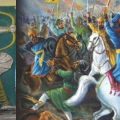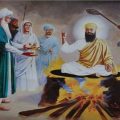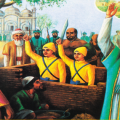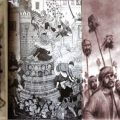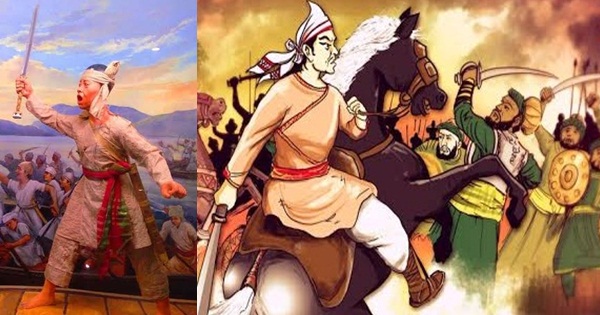
Lachit Barphukan is a household name in Assam, but largely unknown outside of that region. He is perhaps the reason why Assam is a part of India today, retains and celebrates its dharmic and Indic connections. He led the Assamese armies against the Mughals and ensured that Assam remained free.
The Sena dynasty of neighbouring Bengal (by this I mean West Bengal and Bangladesh both) was overthrown by 1206 by Ghiyasuddin Tughlaq and the same year attacks on north east started. They would continue every now and then for next four hundred years – all ending in failures.
In Assam itself, the Tai Ahom dynasty, originating in Myanmar, assumed power in 1228 AD. They too kept out successive invaders from Assam.
But a new and real challenge came with the ascent of Aurangzeb to the Mughal throne. He deputed two of his best generals – Mir Jumla and Diler Khan who were sent to Bengal and from there to Assam. At this particular point in time Assam was in a state of flux. The senapati was from a tribe other than the Tai Ahom and this has caused widespread resentment. The Mughal armies encountered a divided land and people. The unity that had kept out invasion after invasion was now missing. Mir Jumla and Diler Khan had an easy route through Assam and many forts fell without a fight. The Ahom king – Jayadhwaj Singha retreated even further east, leaving his capital Garhgaon – the place is 300 km east of Guwahati. The Mughals managed to install a faujdar at Guwahati. This 1662 – 63 invasion ended with a humiliating treaty being imposed on the Ahom king, which included giving up all territory west of the Barnadi, including the city of Guwahati. Large amounts of cash, war elephants and — giving up his six year old daughter to the Mughal harem. Mir Jumla and Diler Khan also desecrated many ‘maidams’ or burial vaults of the Ahoms.
The king Jayadhwaj Singha dies heartbroken and is succeeded by Chakradhwaj Singha, who now has a monumental task ahead of him. For this, he needs a new senapati or “Barphukan”. The term Barphukan is a rank, not a surname. A leader of all the Phukans in the army was called a “Barphukan”. The Phukan was the highest rank in Ahom army after the Barphukan – commanding 6000 soldiers or paiks.
After deliberations with his ministers, particularly the Prime Minister or the “Rajmantri Dangaria” – Atan Buragohain – Chakradhwaj Singha settles for Lachit and makes him Barphukan.
The challenge before them is immense –
1. Demoralised troops, who do not have any memory of a defeat.
2. Army commanders and ministers divided against themselves, owing to the internal dissent which pervaded everything prior to the Mughal invasion.
3. The knowledge that the troops who had faced defeat at hands of Mughals would now be asked to undo the damage. There was no option of starting with a clean slate.
4. The fact that the Mughal empire was immense and a veteran like Shaiste Khan was Subhedar of the next door province of Bengal.
Nothing is known about Lachit Barphukan’s childhood or early life, other than the fact that he was Momai Tamuli Barbarua’s son. Momai Tamuli Barbarua was a high ranking official in the Ahom kingdom. The Assamese chronicles – or Buranjis – almost exclusively deal with administration, politics and warfare. There is almost no information divulged about the personal life of the Ahom commanders and ministers. It is surmised that Lachit Barphukan was born somewhere around the year 1620.
Lachit Barphukan attended political meetings with his father in his young age, doing the job of carrying the relevant documents and betel nut trays. Later on, he became the scarf bearer. Further on Lachit got promoted to Gorakaksharia Barua – head of the royal stables. Then he was promoted to Dolakaksharia Barua – leader of the royal bodyguard. He was at this rank when the invasion of Mir Jumla happened. During that invasion, he had led his troops with bravery at Dikhowmukh.
He was thus promoted to rank of Barphukan. The situation at this point of time was dicey, and even though some suggested a surprise assault on Mughal held Guwahati, Atan Buragohain cautioned them against it. He was of the firm view, that any attack on Guwahati would invite a retribution from Aurangzeb and the huge armies at his disposal. Lachit Barphukan proudly declared that even if he was the last Ahom alive, he would still fight the Mughals.
So the Ahom king invested the next four years in rebuilding the army into a robust and powerful force. Soldiers were recruited, boats built at dockyards, weapons procured. Cannons made and fortifications strengthened. The king, the Prime Minister and the Barphukan would regularly visit to check the progress being made. All this while pretensions of friendship were maintained with the Mughals – by slowly complying with the terms of the treaty signed between Mir Jumla and Jayadhwaj Singha. This was a diplomatic master stroke, enabling the Ahom to rebuild without inviting suspicion or ruffling feathers at either Guwahati or the capital of Mughal Bengal – Dhaka.
In 1667, the faujdar of Guwahati – Rashid Khan is recalled to Agra and replaced with Firoz Khan. This person sends a direct demand to Chakradhwaj Singha – calling him a vassal and orders him to send young Assamese girls for his pleasure.
The preparations for the war are almost complete, and this insult to their king rallies the people. At the head of a large army, Lachit Barphukan sets off west to recapture Guwahati – after a gap of nearly four years.
The important point to note here, is that the Assamese, lead by the Ahoms, had a very robust military system in place. Yes, the terrain helped them perfect their skills of guerilla warfare, but that was not all. The Ahom military system was based on –
1. The paik system. Every family across the kingdom was required to provide at least three persons for the kingdom. At least one would serve in the army, two if required.
2. There was a definite hierarchy of command – starting with a Deka commanding 10 paiks Bora over 20 paiks, Saikias on 100 paiks, Hazarika of a 1000 paiks, Rajkhowa on 3000 paiks and Phukan of 6000 paiks, etc. The Barphukan was the supreme commander of all of these.
3. They did not have a cavalry arm – owing to the frequent floods of the Brahmaputra and the topography and weather of the land – which made it difficult for large numbers of horses. Instead they had an excellent infantry and something very unique in the Indian context – a riverine Navy. This was the backbone of the Assamese army of those times – and helped them dominate the river Brahmaputra.
4. There were improvements on this riverine navy – such as the panigarh. This would be a quickly built stockade in the middle of the river, on which guns could be mounted and enemy boats and ships countered.
5. Fortifications – A string of forts on either side of the Brahmaputra.
6. A strong network of spies – this enabled them to rebuild the army and procure weapons without arousing suspicion.
Lachit Barphukan, at the head of this large army, attacked many forts near Guwahati. But even after months of siege Guwahati itself could not be captured. The city at that point in time was being protected by the fort of Itakhuli – which was being defended by Syed Firoz Khan himself. It was naturally strong, having the Brahmaputra on one side and well defended by walls and cannons on all others. The Mughal cannons had in fact kept Lachit Barphukan’s soldiers at a safe distance from the fort. A few months passed in this condition of stalemate.
Finally, Lachit Barphukan agreed to a bold plan in which one of his commanders – Ismail Siddiqui or Bagh Hazarika played an important part. This involved sneaking into the fort in the dead of the night in very small numbers – ten or twelve at most and immobilising the cannons by pouring water into them. This daring mission was then carried out by Bagh Hazarika, Japang Gohain and a handful of ace soldiers one August night. The next morning Lachit Barphukan could fearlessly attack Itakhuli! The fort fell into his hands and Guwahati was free once more.
Lachit Barphukan then chased the Mughals all the way to the mouth of the Manas river, freeing forts such as Jogigopha as a result. The Ahom banner once again began fluttering over Assam.
This event in 1667 was Lachit Barphukan’s first claim to fame. It was the result of a careful and calibrated rebuilding of the army which had delivered the goal. But Barphukan knew simply winning Guwahati was not enough, for the Mughals were sure to attack again.
The news of this victory reached the ears of Aurangzeb a few months later. He was determined to recapture Guwahati and finally decided to send Ram Singh. Partly because he held Ram Singh responsible for Shivaji’s escape from Agra, and wanted to test his loyalty. Partly because the architect of the previous victory – Diler Khan was busy in the Deccan.
Ram Singh started at the head of a very large army, totalling over 70,000 soldiers. Following infographic gives a break up of his forces.
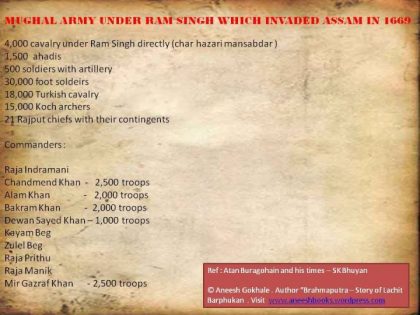
Ram Singh managed to reach Dhaka in 1668 / 69 and had an audience with Shaiste Khan, who assured him of further help against the Assamese and warned him about the land and its peculiarities.
As for Lachit Barphukan, he did not rest on his laurels for even a single day and immediately got down to the work on rebuilding the fortifications and strengthening the forts in view of the impending Mughal invasion. His plan was simple – to build a ring of very strong defenses around Guwahati and fight the Mughals tooth and nail at this point in the Brahmaputra. This was because the Brahmaputra was at its narrowest near Guwahati, thus he intended to trap the Mughals at this point in the river, much like one would choke an army in a narrow mountain pass (strategem). Sufficient number of paiks were placed to guard the fortifications.
One incident which happened during the building of these embankments around Guwahati which has since become part of Assamese folklore.
Lachit Barphukan’s plan was simple – he intended to fortify and guard the city of Guwahati so as to prevent the Mughals from sailing further east to Garhgaon, the capital. All possible resources were thrown into the war effort. By the time Ram Singh reached Dhaka from Agra and began sailing towards Guwahati, the embankments and fortifications were complete – save for one very crucial patch. The person in charge was Lachit’s own maternal uncle. Lachit Barphukan realized that time was short and exhorted his uncle to keep working through the night so that the embankment would be complete. It was after all , just a question of a few more hours of work. But Lachit’s uncle completely ignored his orders! The next morning, Lachit Barphukan beheaded his own maternal uncle for dereliction of duty and being callous towards defending the Brahmaputra Valley. For Lachit Barphukan, his attitude amounted to treason – punishable by death. The exact location of the embankment is unknown, but the story itself is very popular as Assamese folklore.
This raised Lachit Barphukan’s stature immeasurably in the eyes of the people and soldiers and they coalesced as one to face the Mughal threat.
Ram Singh began attacking the western outposts of the Ahom kingdom by 1669 and as planned, the soldiers retreated towards Guwahati, luring Ram Singh into the trap.
Ram Singh, seeing that he had easily gained a number of forts, grew haughty and believed his work was already done. In reality, he had almost fallen into the trap.
Ram Singh then sent a bag of poppy seeds to Lachit Barphukan, with the message that the Mughal army was as numerous as the seeds in the bag. Not one to bear an insult, either on the battle field or in diplomacy, Lachit Barphukan as a reply sent a tube full of sand from the river bank! The message being that the Assamese army was as numerous as grains of sand. And while the poppy seeds could be ground into a paste, the sand was insoluble!
Now this message was sent to Ram Singh via two envoys – Nim and Ramcharan. At the Mughal camp, they noticed two exquisitely carved wooden birds, and took an instant liking to them. Although their job was only to deliver a message, Ram Singh persuaded Nim to accept two of the birds as a gift!
Lachit Barphukan was livid on getting this piece of news! Dereliction of duty was not a trait he was looking for.
Thus, these two incidents showed the entire army that Lachit Barphukan meant to lead by example and indiscipline in the ranks when faced with a mortal danger would not be tolerated. The result was that the Assamese stood together like one monolithic rock in spite of the best of efforts by Ram Singh.
All attempts at conquering various forts were beaten back. Ram Singh sent part of his army to sneak in via a pass in Darrang, this too was found out and the soldiers mercilessly slaughtered. In general, the year 1669 ended with victories for Lachit Barphukan.
Finally a time came when the two armies were left facing each other on the opposite ends of the fields of Alaboi. Ram Singh then tried to sow dissent in the ranks of his enemy. made. Commanders who were not very happy with Lachit in charge were offered huge bribes.
Lachit was wary of facing the Mughals in an open field, knowing full well that his own army did not consist of any cavalry, and his nemesis had perhaps the best cavalry. It would be suicide for his foot soldiers to face a cavalry charge. But the dissent being sown by Ram Singh and the long delays on the battlefield managed to make Raja Chakradhwaj Singha force his hand — and he issued an ultimatum to Lachit Barphukan to engage Ram Singh.
Much against his wishes, Lachit Barphukan was forced to battle Ram Singh in the open fields (5th Aug 1669). It ended as expected – a terrible disaster, with Lachit Barphukan losing over 10,000 of his best soldiers.
But the battle was a shot in the arm for Raja Ram Singh. Aurangzeb heard of it from Shaiste Khan and immediately increased Ram Singh’s mansab to 5000, making him a mansabdar of considerably high rank. He further asked him to push forward and capture Guwahati. Seasoned sailors like Munnawar Khan and Mohammed Saleh Karoh were deputed to aid him. White skinned freebooters and mercenaries plying around Bengal also joined the fray on the side of the Mughals.
In the meanwhile, negotiations had been opened between the Mughals and the Assamese, interspersed with skirmishes as before. Udayaditya Singha succeeded Chakradhwaj Singha in 1670 in the midst of all this.
Thus the year 1670 more or less passed with little happening of note.
By the beginning of 1671 Mughals also had built up their army, with the arrival of the firangees, fresh soldiers, Munnawar Khan and Mohamed Saleh Karoh to the Brahmaputra. Lachit Barphukan on his part was not slack. The forts were strengthened, pickets posted and a further twenty thousand soldiers requested to be sent from Garhgaon.
Ram Singh discovered through his spies that there was a breach in the long line of embankments guarding Guwahati at Andurabali. Here was a golden chance to break through and capture the all important fort.
And at this critical juncture, with the Mughal armies amassing on the Brahmaputra with as many as forty war ships each carrying 16 guns and many smaller boats, Lachit Barphukan fell ill. To the extent that he could hardly stand and move around.
In the month of March 1671, the battle began. It would go down in Assam and India’s history as the Battle of Saraighat. The grand climax to a series of events set in motion eight years ago with the invasion of Mir Jumla. It was unique, for it was the only major battle in India to have been fought entirely on a river! But then the river Brahmaputra is gigantic in proportions – being a kilometre wide even at its narrowest point at Guwahati!
With their commander bed ridden, the Assamese faced off against the Mughals who were making one last determined effort to force their way through the breach at Andurabali and conquer Guwahati once more. In the absence of a leader, their movements were haphazard and the Mughal attack was devastating. Before long, withering in the face of the concerted attack, the Assamese began retreating their steps eastward!
Lachit Barphukan heard of this retreat and was livid. Much against the wishes of his vaidya and astrologers, he decided to join the war.
“I shall be the last one to leave the battlefield” he declared proudly.” And if I die, bury my mortal remains on a small plot of land I have bought on a nearby hill for the princely sum of four cowries”. But Lachit Barphukan would not lie on his sickbed while his soldiers were getting slaughtered.
He stepped into his warboat and unfurled the flag. That itself was like Adrenalin for his soldiers. Nothing could go wrong now!
The Ahoms turned around and faced the Mughals once more. Between the watery triangle formed by the temple of Kamakhya, the Vishnu Mandir at Aswaklanta and the Itakhuli Hill Fort, a grand battle ensued. The Assamese made use of improvised defenses – such as the Panigarh — stockades built in middle of the water from where they could easily fire on the Mughals. Bridges of boats were built, acting like fortified barriers. The small Ahom Bacchari boats were handled swiftly and deftly by their commanders, leaving the large war boats of the Mughals clueless. Lachit Barphukan and the Ahoms had perfected the art of fighting on the mighty river and it was at Saraighat that they scored their biggest victory.
By the end of that day in March 1671, the Mughals were in retreat and would never again make a sincere attempt at annexing Assam.
Lachit Barphukan – Legacy and Importance
Lachit Barphukan’s victory halted the Mughal march into Assam. It kept political control with the Ahoms. It was on this foundation that later day rulers like Rudra Singha could truly blossom and build many temples, tanks and give a cultural boost to Assamese society.
We do not know what would have happened in case of a Mughal victory. Total annihilation? Vassalage? The ruling dynasty destroyed with the incumbent cruelly killed? Destruction of temples? We do not know, but all of the above had already been done by Aurangzeb or would do in the years to come. But Lachit Barphukan prevented all of that through his valiant leadership.
The present shape of India is a sum total of all the various contributions through the ages by innumerable personalities. Each of them, battled in their own way to uphold Indic culture, and led us to where we are today.
